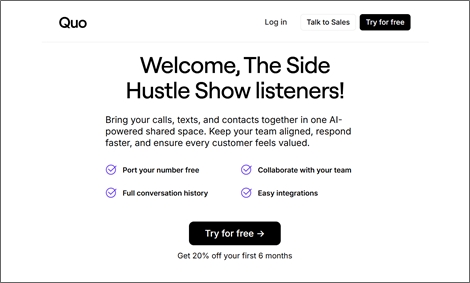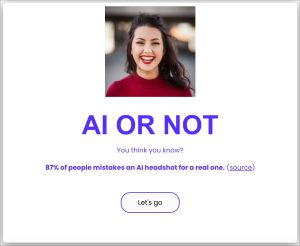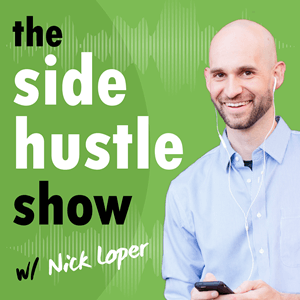
What if you could build a six-figure business in under 2 years — with zero technical skills and almost no marketing budget?
Tanya Van Gastel did exactly that with TheMultiverse.ai, an AI-powered headshot generator that turned selfies into professional photos.
She started with just $9 per sale, scaled to $29, drove over $350,000 in revenue, and sold the business — all while working with two co-founders and learning marketing from scratch.
In this episode, Tanya pulls back the curtain on how she found customers, grew through SEO and affiliates, pivoted to corporate clients, and ultimately prepared the business for acquisition.
Listen to Episode 700 of the Side Hustle Show to learn:
- How to enter a crowded market and still win
- Low-cost marketing tactics that actually scale
- The real difference between SEO and “GEO” (generative engine optimization)
- How to position a business for sale even without recurring revenue
Sponsors
- Mint Mobile — Cut your wireless bill to $15 a month!
- Indeed – Start hiring NOW with a $75 sponsored job credit to upgrade your job post!
- Quo (formerly OpenPhone) — Get 20% off of your first 6 months!

- Shopify — Sign up for a $1 per month trial!
- Policygenius — Compare free life insurance quotes from top companies and see how much you could save.
You Don’t Need to Be First (Or Even Top 5) to Win
When Tanya and her co-founders launched TheMultiverse.ai in April 2023, there were already about 10 other AI headshot generators on the market.

Most people would see that as a red flag. But Tanya saw it differently.
“You don’t actually need to be the number one to make a really good living for yourself,” she explained.
The market was still small enough that most people — including potential customers’ own parents — had never even heard of AI headshots.
The rising tide lifted all boats. As awareness grew, so did opportunity.
Within six months, they hit $5,000 per month in revenue. That early traction validated one key insight: there’s more market than you think, especially in emerging categories.
Here are some of the best headshots it generated for me:



(I used promo code GET95 for 20% off.)
Building the Product (Without Being Technical)
Tanya isn’t a developer. She comes from a marketing and PR background. But one of her co-founders was an engineer who built the platform from scratch.
Two years ago, building an AI product required serious technical skills. Today, no-code tools make it easier:
Tanya even built a mental health app called Capybara Affirmations as a learning project. It attracted 10,000 users in the first month — completely as a non-technical founder.

The technical barriers to launching AI products keep getting lower. The key is starting with a clear value proposition and keeping it simple.
5 Marketing Tactics: Reddit, SEO, and Affiliates
Tanya came from a traditional marketing background — teams, budgets, agencies. But Multiverse had none of that.
So she got scrappy.
Reddit (The Early Days)
Tanya spent hours searching Reddit for headshot-related threads and commenting with links to TheMultiverse.ai. She created multiple accounts, knowing most would get banned.
“That’s actually how we got our first $500 in revenue,” she said. “ That was such a magical moment.”
Her pro tip: Don’t post in entrepreneur or side hustle subreddits where everyone’s trying to sell. Go where your actual customers are.
Use tools like Ahrefs or SEMrush to find the most popular Reddit posts by keyword, then comment on those high-traffic threads.
And don’t just spam links. Study the top posts in your subreddit, screenshot them, and ask ChatGPT to write similar posts in that style. The format matters as much as the message.
SEO: The Bread and Butter
For Tanya, SEO was the real growth engine.
She wrote a listicle titled “Best AI Headshot Generators” and ranked TheMultiverse.ai at number one. That article held the top spot on Google for nearly six months.
“If you’re like a journalist doing research for an article… you’re just gonna Google potential companies that you can review,” Tanya explained.
That’s how TheMultiverse.ai landed mentions in Rolling Stone, Forbes, and other major outlets.
The key was targeting bottom-of-funnel keywords like “best AI headshot generator” and “headshots for remote teams.” These weren’t massive traffic drivers, but they converted at around 5%.
Affiliate Marketing: The 30% Commission Model
Affiliate marketing became one of the biggest revenue drivers.
Multiverse.ai offered affiliates 30% of every sale. The best-performing affiliate writer was making $10,000 per month, which meant they were driving $30,000 in revenue to the business.
“We didn’t have to prepay them. We post-pay them. And for the affiliate writer, they’re doing really great revenue just from writing SEO articles,” Tanya said.
The strategy was two-pronged:
- Passive affiliates: Bloggers who found TheMultiverse.ai organically and added it to their listicles
- Proactive outreach: Tanya used Ahrefs to find top-ranking articles, then reached out to ask for inclusion
Some high-ranking bloggers quoted fees as high as $5,000 for a top placement. Tanya would run the math: traffic × conversion rate × customer value. If it made sense, she’d pay.
“You’re basically seeing that it’s an ad placement at that point,” she said.
For affiliate tracking, Tanya used Rewardful, calling it “the easiest to set up affiliate program I’ve ever used.”
Conversion rates from affiliates were exceptional — around 12% on the homepage, nearly triple the rate from SEO traffic.
Pivoting to B2B: The $4,000 Corporate Sale
Multiverse started as a B2C product. But then a corporate client bought $4,000 worth of headshots in one order.
That changed everything.
“We only need to convince one decision maker and they can actually buy 400 headshots at once instead of needing to convince 400 people,” Tanya realized.
The value proposition for remote teams was clear: How do you get consistent headshots for a distributed workforce?
You can’t send a photographer to five cities. And if someone new joins, their headshot won’t match the rest of the team.
AI headshots solved that.

Tanya focused SEO content on terms like “team headshots” and “headshots for remote teams.” She also offered free trial packages to companies, asking them to post results on LinkedIn.
Cold email outreach didn’t work as well. But SEO-driven inbound interest? That converted.
Is It AI or Not? The Viral Quiz
About a year into the business, Tanya built a quiz called “AI or Not.”

Users were shown 10 photos and had to guess which were AI-generated and which were real.
Almost no one got a perfect score. “Most people couldn’t get more than a 5 out of 10,” Tanya said. Less than 0.1% scored 10/10.
(I got a 6.)
The quiz served two purposes:
- Engagement: It kept users on the site while their headshots were processing
- Social proof: It showed just how realistic AI headshots had become
The takeaway for any visual product: Can you gamify the experience? Can you make it shareable?
What Is GEO (Generative Engine Optimization)?
Tanya is now focused on a new field: GEO (Generative Engine Optimization) — getting your business recommended by ChatGPT and other AI models.

It’s not the same as SEO.
“ChatGPT is really about mentions. It’s not about ranking factors,” Tanya explained.
The AI pulls from its training data, which could be six months to a year old. If you’re mentioned frequently in that data, you’ll surface in responses.
But it’s probabilistic. Ask ChatGPT the same question three times, and you might get three different answers. The goal isn’t to be mentioned 10 out of 10 times — it’s to aim for 8 out of 10.
How to Optimize for GEO
- Get mentioned on Reddit. It’s the most-cited domain in ChatGPT by far — double the next closest source
- Create FAQ-style content. ChatGPT looks for questions being asked on the web. If your blog post mirrors the user’s prompt, it’s more likely to surface
- Build a strong features page. Explicitly list what your product does. “ChatGPT isn’t really good at reasoning. If you’re not saying it verbatim, it’ll be very hard for it to pick it up”
- Audit your brand. Ask ChatGPT what people say about your company. Check the citations to see where the info is coming from—then fix any inaccuracies
Tanya also noted that ChatGPT now uses Google’s search API for some queries via a third-party tool called SerpApi. So there’s overlap, but GEO still requires its own strategy.
For a deeper dive into this emerging field, check out Tanya’s work at RankingOnAI.com.
Preparing the Business for Sale
After nearly two years, Tanya and her co-founders decided to sell.
The timing made sense. ChatGPT had just launched an image generator that could almost do what Multiverse.ai did. It wasn’t quite there yet, but the writing was on the wall.
“Within these kind of cutting-edge companies, when you are making something that you can easily be replaced by ChatGPT and you have a potential for an exit, that was super attractive to us,” Tanya said.
They listed on Flippa, a marketplace for buying and selling online businesses.
The Unexpected Buyer
Tanya assumed the buyer would be another AI company or a photography service.
Instead, it was an e-commerce player.
“We were a completely digital product that we had never tried to do anything with ads and had no experience with it.” Tanya explained. “There was a really high potential for them to be able to push those ads and also not have to deal with logistics.”
The buyer saw upside where Tanya saw limitations. That’s the power of listing publicly — you never know who’s looking.
Tools and Resources
- Rewardful: Affiliate tracking
- Ahrefs: SEO research and Reddit post analysis
- Flippa: Business marketplace for buying and selling
- RankingOnAI.com: Tanya’s new GEO-focused agency
Tanya’s #1 Tip for Side Hustle Nation
“Don’t give up. Success is just failure to failure.”
Want more strategies for building and scaling digital products? Check out episode 689 with Pete McPherson on AI-powered product ideas.
And if you want my best side hustle ideas and insider updates delivered to your inbox every week, head to sidehustlenation.com/join and get on the list.
Episode Links
- TheMultiverse.ai
- Lovable
- Pickaxe
- Capybara Affirmations
- Ahrefs
- SEMrush
- Best AI Headshot Generators
- Multiverse.ai Affiliate Program
- Rewardful
- AI or Not
- SerpApi
- RankingOnAI.com
- Flippa
- Episode 673: How to Drive Traffic from Reddit
- Episode 181: SEO, Affiliate Marketing, Self-Publishing, Udemy, and More
- Episode 617: Scaling to a 7-Figure Sale: Affiliate Marketing Beyond SEO
- Episode 689: 18 AI-Assisted Product Ideas You Could Build and Sell
Looking for More Side Hustle Help?
- Start Your Free $500 Challenge. My free 5-day email course shows you how to add $500 to your bottom line.
- Join the free Side Hustle Nation Community. The free Facebook group is the best place to connect with other side hustlers and get your questions answered.
- Download The Side Hustle Show. My free podcast shares how to make extra money with actionable weekly episodes.














